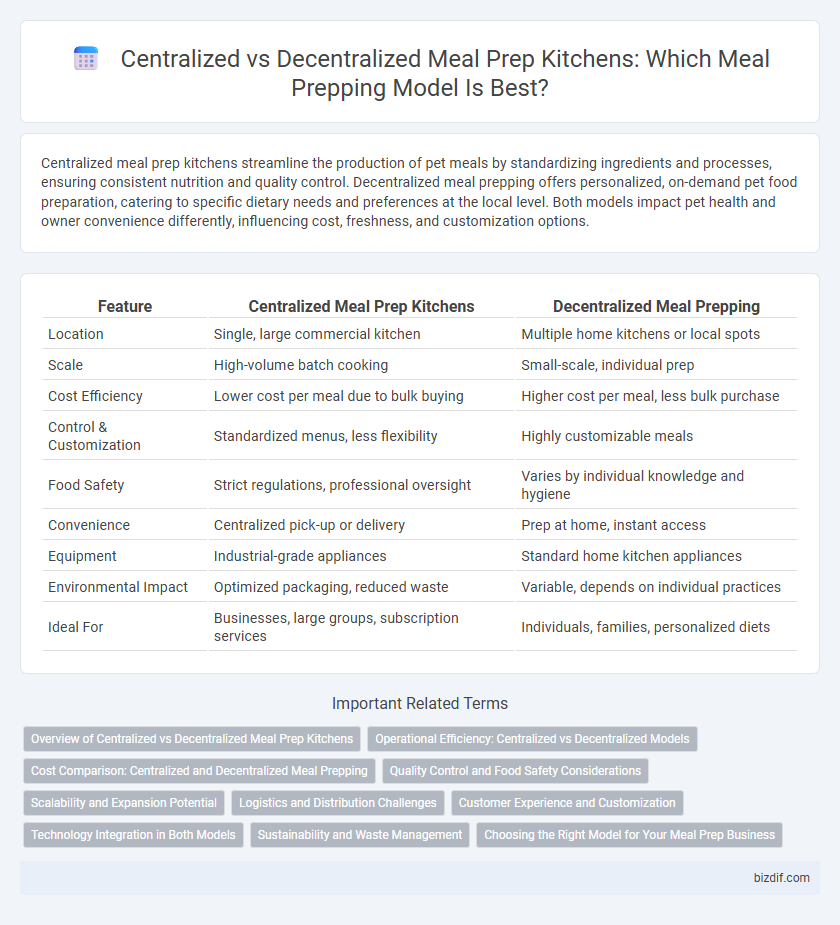Centralized meal prep kitchens streamline the production of pet meals by standardizing ingredients and processes, ensuring consistent nutrition and quality control. Decentralized meal prepping offers personalized, on-demand pet food preparation, catering to specific dietary needs and preferences at the local level. Both models impact pet health and owner convenience differently, influencing cost, freshness, and customization options.
Table of Comparison
| Feature | Centralized Meal Prep Kitchens | Decentralized Meal Prepping |
|---|---|---|
| Location | Single, large commercial kitchen | Multiple home kitchens or local spots |
| Scale | High-volume batch cooking | Small-scale, individual prep |
| Cost Efficiency | Lower cost per meal due to bulk buying | Higher cost per meal, less bulk purchase |
| Control & Customization | Standardized menus, less flexibility | Highly customizable meals |
| Food Safety | Strict regulations, professional oversight | Varies by individual knowledge and hygiene |
| Convenience | Centralized pick-up or delivery | Prep at home, instant access |
| Equipment | Industrial-grade appliances | Standard home kitchen appliances |
| Environmental Impact | Optimized packaging, reduced waste | Variable, depends on individual practices |
| Ideal For | Businesses, large groups, subscription services | Individuals, families, personalized diets |
Overview of Centralized vs Decentralized Meal Prep Kitchens
Centralized meal prep kitchens consolidate cooking, packaging, and distribution in one facility, optimizing resource use and maintaining consistent quality across large batches. Decentralized meal prepping involves multiple smaller kitchens or individual home-based preparations, offering flexibility and customization but potentially increasing logistical complexity and costs. The choice between centralized and decentralized models depends on factors like scale, target market, quality control priorities, and distribution efficiency.
Operational Efficiency: Centralized vs Decentralized Models
Centralized meal prep kitchens streamline operations by consolidating resources, reducing food waste, and enhancing inventory management, leading to lower costs and faster meal production. Decentralized meal prepping offers flexibility and customization at local levels but often faces challenges in maintaining consistent quality and scaling efficiently. Operational efficiency favors centralized models due to standardized processes and optimized logistics that minimize redundancies and improve turnaround times.
Cost Comparison: Centralized and Decentralized Meal Prepping
Centralized meal prep kitchens typically reduce overall costs by purchasing ingredients in bulk and utilizing shared equipment, resulting in lower per-meal expenses. Decentralized meal prepping often incurs higher costs due to duplicated ingredient purchases, individual kitchen setups, and less efficient use of resources. Analyzing these cost factors is essential for businesses and households aiming to optimize meal prep budgets.
Quality Control and Food Safety Considerations
Centralized meal prep kitchens offer stringent quality control through standardized processes and consistent food safety protocols monitored by trained staff, reducing contamination risks. Decentralized meal prepping, managed at individual or small group levels, faces challenges maintaining uniform safety standards, increasing variability in hygiene and food handling practices. Implementing digital tracking and regular audits in decentralized setups can mitigate some safety concerns but generally, centralized kitchens provide superior oversight and compliance with regulatory guidelines.
Scalability and Expansion Potential
Centralized meal prep kitchens offer superior scalability by consolidating resources, equipment, and staff in a single location, enabling streamlined operations and consistent quality control. This centralized model supports rapid expansion into new markets with standardized processes and economies of scale. Decentralized meal prepping, while flexible and locally adaptive, faces challenges in maintaining uniformity and scaling efficiently across multiple sites.
Logistics and Distribution Challenges
Centralized meal prep kitchens streamline logistics by consolidating production in a single location, enabling efficient bulk purchasing and standardized quality control but face distribution challenges such as higher transportation costs and longer delivery times. Decentralized meal prepping reduces delivery distances and allows for faster local distribution, yet it complicates inventory management and increases variability in meal quality due to dispersed operations. Balancing these logistics and distribution factors is critical for optimizing freshness, cost efficiency, and scalability in meal prep services.
Customer Experience and Customization
Centralized meal prep kitchens streamline operations by offering consistent quality and efficient delivery, enhancing customer experience through reliability and time-saving convenience. Decentralized meal prepping provides greater customization, allowing customers to tailor meals to personal preferences or dietary needs with fresher, locally sourced ingredients. Both models impact customer satisfaction differently, with centralized kitchens excelling in scalability and decentralized approaches excelling in personalized meal options.
Technology Integration in Both Models
Centralized meal prep kitchens leverage advanced automation technologies and integrated inventory management systems to optimize large-scale food production and ensure consistency across meals. Decentralized meal prepping benefits from cloud-based platforms and mobile apps that enable personalized meal planning, real-time dietary tracking, and efficient communication between users and local suppliers. Both models increasingly use AI-driven analytics to forecast demand, reduce waste, and enhance operational efficiency.
Sustainability and Waste Management
Centralized meal prep kitchens significantly reduce food waste through bulk purchasing and standardized portion control, enhancing sustainability by minimizing packaging and energy consumption per meal. Decentralized meal prepping allows for personalized waste management but often results in higher overall resource use due to duplicated equipment and inconsistent waste reduction practices. Implementing centralized systems leverages economies of scale to optimize resource efficiency and promote sustainable food distribution models.
Choosing the Right Model for Your Meal Prep Business
Centralized meal prep kitchens streamline operations by consolidating cooking and packaging in a single location, enhancing consistency and cost-efficiency for scaling businesses. Decentralized meal prepping offers flexibility and local customization, allowing chefs to cater to specific regional tastes and reduce delivery times. Selecting the appropriate model depends on business size, target market, and distribution logistics to optimize quality control and operational efficiency.
Centralized meal prep kitchens vs decentralized meal prepping Infographic

 bizdif.com
bizdif.com